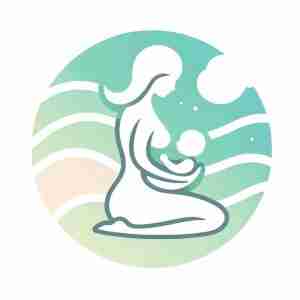Pregnancy and childbirth place enormous strain on the female body, particularly on the pelvic floor postpartum. This often underestimated muscle group plays a central role in supporting the pelvic organs and controlling the bladder and bowel. After childbirth, it is essential to restore the health and strength of the pelvic floor to avoid long-term issues such as incontinence and prolapse.
Key Points:
- The pelvic floor needs a lot of rest immediately after childbirth. Particularly in the first two weeks postpartum, you should lie down a lot and avoid (too much) walking.
- Afterwards, you can continue with awareness exercises and try to gently contract the pelvic floor to activate it.
- Avoid heavy lifting (anything heavier than your baby) and try to maintain an upright posture.
- Relieve the pelvic floor by getting up only from a side-lying position.
- A fiber-rich diet: Healthy digestion reduces the risk of constipation, which in turn relieves the pelvic floor.
Structure of the Pelvic Floor

The pelvic floor is like a hammock made of muscles and tissues lining the lower part of the pelvis. It holds important organs like the bladder, bowel, and in women, the uterus, in place.
The pelvic floor consists of three layers, each with a specific location and function:
- Deepest Layer (Diaphragma pelvis)
- Location: This layer is located deep within the pelvis, extending from the pubic bone to the coccyx and to the lateral pelvic walls.
- Function: It forms the main supportive structure of the pelvic floor, stabilizes the spine, and supports pelvic organs like the bladder, uterus, and bowel. This layer is also important for bowel control.
- Middle Layer (Diaphragma urogenitale)
- Location: This layer is above the deepest layer, spanning between the ischial tuberosities and the pubic bone.
- Function: It supports the urethra and, in women, the vagina. This layer plays a significant role in bladder control and provides additional stability for the pelvic organs.
- Superficial Layer (External sphincters and erectile tissues)
- Location: This layer is located directly under the skin in the perineum, the area between the anus and genitals.
- Function: It includes the sphincter muscles responsible for controlling urine and bowel movements, and the muscles supporting the erectile tissues, influencing erection in men and vaginal opening tension in women. This layer also contributes to the overall stabilization of the pelvic floor.
Together, these three layers work to support the internal organs, ensure continence, support sexual function, and facilitate childbirth in women.
The Importance of the Pelvic Floor and Its Functions
The pelvic floor performs several important functions essential for overall health and well-being:
- Support of Pelvic Organs: The pelvic floor acts as a hammock, holding internal organs like the bladder, uterus, and bowel in place, preventing prolapse.
- Continence: The pelvic floor plays a crucial role in bladder and bowel control. The interplay of muscles and sphincters regulates the release of urine and stool. Strong pelvic floor muscles help prevent incontinence.
- Support During Childbirth: In women, the pelvic floor assists in guiding the baby through the birth canal. A flexible and strong pelvic floor can ease childbirth and prevent injuries.
- Sexual Function: The pelvic floor contributes to sexual health. In women, it supports vaginal tension and sensation, enhancing sexual satisfaction and sensation during intercourse.
- Stabilization and Posture: The pelvic floor works with the abdominal and back muscles to ensure core stability and support a healthy posture, which is crucial for preventing back pain and posture issues.
- Breathing: The pelvic floor works with the diaphragm to support breathing. During inhalation, the pelvic floor slightly lowers, and during exhalation, it rises again, playing a significant role in the breathing cycle.
A well-functioning pelvic floor is thus essential for supporting internal organs, controlling bladder and bowel functions, ensuring sexual health, stabilizing the body, and aiding breathing.
Impact of Pregnancy and Childbirth
During pregnancy and childbirth, the pelvic floor undergoes significant changes:
- Hormones: Hormones like relaxin and progesterone loosen connective tissues and muscles to make room for the baby.
- Weight Gain: The additional weight of the baby and uterus puts pressure on the pelvic floor.
- Birth Trauma: The stretching and tearing of muscles and nerves during childbirth can lead to weakness and injuries.
Pelvic Floor Directly Postpartum – What Is Normal? Tips for Relieving the Pelvic Floor After Birth
After childbirth, the pelvic floor, subjected to significant strain during pregnancy and delivery, undergoes a major healing process. It is important to understand what is normal for the pelvic floor postpartum:
- Weakness and Laxity: It is normal for the pelvic floor to feel weak and lax immediately after childbirth. The muscles and connective tissues were heavily strained and overstretched and need time to recover.
- Tip 1: Lie down a lot, especially in the first two weeks postpartum, to allow the pelvic floor to recover.
- Incontinence: Many women experience some degree of urinary or fecal incontinence in the first weeks after childbirth. This is a common result of weakened pelvic floor muscles and should improve over time with targeted exercises.
- Tip 2: Go to the bathroom regularly, as you may not feel the need to urinate. Try to go every 2 hours.
- Feeling of Pressure: Some women feel a pressure or heaviness in the pelvic area. This can be caused by the relaxation and stretching of the pelvic floor muscles during childbirth and should gradually improve.
- Tip 3: If you feel pressure downwards, you may have overexerted yourself. Try to rest more. Avoid walks (or keep them very short). Lie down as much as possible to help the pelvic floor recover.
- Problems with Bowel Movements: Difficulty with bowel movements or a feeling of incomplete emptying is common and can be due to impaired pelvic floor function.
- Tip 4: Do not strain during bowel movements, breathe deeply, and take your time. This helps protect the pelvic floor, though it can still be uncomfortable in the first weeks postpartum.
After childbirth, the pelvic floor primarily needs rest, gentle activation, and targeted support to fully recover and strengthen. In particular, during the early postpartum period (the first 10-14 days), you should mostly lie down to relieve the pelvic floor. From personal experience, I know that some babies want to be held a lot in the first 14 days. Try to get help so that you can still rest and recover.
Signs of a Weak Pelvic Floor
A weak pelvic floor can exhibit various signs and symptoms. The most common include:
- Incontinence
- Stress Incontinence: Involuntary loss of urine during physical activity, laughing, coughing, or sneezing.
- Urge Incontinence: Sudden, strong urge to urinate with possible involuntary urine loss.
- Fecal Incontinence
- Involuntary loss of stool or difficulty controlling bowel movements.
- Prolapse Symptoms
- Feeling of pressure or heaviness in the pelvic area, as if something is “falling out.”
- Visible or palpable bulge in the vaginal area in women.
- Pelvic Pain
- Pain or discomfort in the lower back, pelvic area, or vagina in women.
- Difficulty Urinating
- Difficulty emptying the bladder completely.
- Weak or interrupted urine stream.
- Sexual Problems
- Pain during intercourse.
- Decreased sensations or difficulty achieving orgasm.
- Chronic Constipation
- Regular difficulty with bowel movements not explained by diet or fluid intake issues.
- Frequent Urination
- Frequent urge to urinate, even without a full bladder.
Pelvic Floor Exercises
Gentle pelvic floor exercises are essential for gradually rebuilding the muscles. These exercises should ideally be done under the guidance of a midwife or specialized physiotherapist to ensure they are performed correctly and effectively. Additionally, avoid activities that heavily strain the pelvic floor, such as heavy lifting, intense abdominal workouts, or strenuous sports. Instead, opt for gentle movements like light walking and specific postpartum gymnastics. Pelvic floor-friendly behavior also includes regular breaks to avoid overloading the body and maintaining an upright posture that relieves the pelvic floor. It is important to listen to your body and give it the necessary time to regenerate. Furthermore, conscious breathing, where the pelvic floor is lightly contracted during exhalation, can help support and strengthen the muscles.
Rehabilitating the Pelvic Floor Postpartum
Restoring pelvic floor function after childbirth requires targeted exercises and sometimes professional help. Here are some steps for rehabilitation:
- Pelvic Floor Exercises (Kegel Exercises): Kegel exercises are the foundation of any pelvic floor rehabilitation. They strengthen the muscles and improve control over the bladder and bowel.
- How to Perform Kegel Exercises:
- Identify the right muscles: Imagine you need to stop the flow of urine.
- Contract these muscles and hold the contraction for 5-10 seconds.
- Fully relax the muscles and repeat the exercise 10-15 times, several times a day.
- How to Perform Kegel Exercises:
- Physiotherapy: A specialized physiotherapist can create a tailored program and use techniques like biofeedback and electrical stimulation to strengthen the muscles.
- Deep Muscle Training: The pelvic floor is part of the body’s 4-part system consisting of deep abdominal muscles (transversus abdominis), deep back muscles, diaphragm, and pelvic floor. These four parts are important for stabilizing the core and holding the organs in place. After pregnancy, these muscles are often overstretched or too weak to perform their function.
Conclusion
Caring for and rehabilitating the pelvic floor postpartum is crucial for long-term well-being and quality of life for women. Through targeted exercises, professional support, and healthy lifestyle habits, pelvic floor function can be restored and strengthened to prevent common postnatal issues. Awareness of these topics and early intervention are key to supporting pelvic floor health.
References:
Bø, K., et al. (2007). “Pelvic floor muscle training for the treatment of urinary incontinence in women: a systematic review.” British Journal of Sports Medicine.
Dumoulin, C., et al. (2018). “Pelvic floor muscle training versus no treatment, or inactive control treatments, for urinary incontinence in women.” Cochrane Database of Systematic Reviews.
Mørkved, S., Bø, K. (2014). “Effect of pelvic floor muscle training during pregnancy and after childbirth on prevention and treatment of urinary incontinence: a systematic review.” BJOG: An International Journal of Obstetrics & Gynaecology.
Tennfjord MK, Engh ME, Bø K, The Influence of Early Exercise Postpartum on Pelvic Floor Muscle Function and Prevalence of Pelvic Floor Dysfunction 12 Months Postpartum, Physical Therapy, Volume 100, Issue 9, September 2020, Pages 1681–1689, https://doi.org/10.1093/ptj/pzaa084
Ptak M, Ciećwież S, Brodowska A, Starczewski A, Nawrocka-Rutkowska J, Diaz-Mohedo E, Rotter I. The Effect of Pelvic Floor Muscles Exercise on Quality of Life in Women with Stress Urinary Incontinence and Its Relationship with Vaginal Deliveries: A Randomized Trial. Biomed Res Int. 2019 Jan 6;2019:5321864. doi: 10.1155/2019/5321864. PMID: 30723739; PMCID: PMC6339740.
Molina-Torres G, Moreno-Muñoz M, Rebullido TR, Castellote-Caballero Y, Bergamin M, Gobbo S, Hita-Contreras F, Cruz-Diaz D. The effects of an 8-week hypopressive exercise training program on urinary incontinence and pelvic floor muscle activation: A randomized controlled trial. Neurourol Urodyn. 2023 Feb;42(2):500-509. doi: 10.1002/nau.25110. Epub 2022 Dec 8. PMID: 36482844; PMCID: PMC10107869.
Bi X, Zhao J, Zhao L, Liu Z, Zhang J, Sun D, Song L, Xia Y. Pelvic floor muscle exercise for chronic low back pain. J Int Med Res. 2013 Feb;41(1):146-52. doi: 10.1177/0300060513475383. Epub 2013 Jan 23. PMID: 23569140.
Diz-Teixeira P, Alonso-Calvete A, Justo-Cousiño LA, González-González Y, Cuña-Carrera ID. Update on Physiotherapy in Postpartum Urinary Incontinence. A Systematic Review. Arch Esp Urol. 2023 Feb;76(1):29-39. doi: 10.56434/j.arch.esp.urol.20237601.2. PMID: 36914417.

Sonja ist Ernährungswissenschaftlerin und promovierte Epidemiologin mit langjähriger Erfahrung in der Gesundheitsforschung. Seit der Geburt ihrer beiden Kinder 2019 und 2023 beschäftigt sie sich intensiv mit dem Thema Rückbildung und der Thematik, wie man wieder einen gesunden und schönen Körper mit stabiler Mitte nach der Schwangerschaft bekommen kann. Sie möchte Euch helfen, nach der Schwangerschaft wieder fit zu werden!